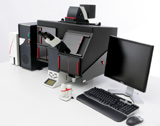Jul 21 2007
The new Leica AM TIRF MC (Multi-color, Total Internal Reflection Fluorescence) system allows the entire fluorescence excitation spectrum to now be used for real-time visualization of live cell dynamics.
 New Leica AM TIRF MC (Multi-color, Total Internal Reflection Fluorescence) system.
New Leica AM TIRF MC (Multi-color, Total Internal Reflection Fluorescence) system.
Leica's unique scanner sensor automatically matches the TIRF angle at all wavelengths to the required penetration depth, and positions the laser so that the TIRF penetration depth remains constant even when the wavelength is changed. Researchers using Leica's TIRF technology benefit from a unique level of convenience as well as from reproducible scientific results.
The Leica AM TIRF MC integrates four solid-state lasers for the excitation of fluorophores at wavelengths from 405 to 632nm. The system features extremely short switching times and an ultra-high synchronized frame rate. For the scientist, this means excellent flexibility for experiments with multiple fluorophores. The system is particularly useful for exploring molecular interaction at cell membranes and molecular interaction of proteins and receptors involved in transport mechanisms. With the Leica AM TIRF MC, a scientist can examine single molecules near the cell membrane, study co-localization and vesicle transport, and combine TIRF and fast FRET analysis.
The Leica AM TIRF MC provides wavelengths of 405, 488, 561, and 632nm for multi-color applications. Individual laser lines are paired and controlled quickly and precisely via AOTF (Acousto-Optical Tunable Filters) during a switching time of only 1ms.
Leica's newly designed SyncBoard controls the fast frame rate of up to 30fps. This high temporal resolution for the excitation of multiple fluorophores, combined with the high spatial TIRF resolution of 70-300nm in the z-axis, are key prerequisites for visualizing transport processes in cell membranes or protein interactions in real time. Even individual molecule interaction, kinetics, and co-localization can be visualized and measured with Leica's highly sensitive TIRF system. Maintaining constant penetration depth when the laser lines are switched is an essential requirement for the use of multiple fluorophores. With an excellent signal-to-noise ratio, the entire dynamic range of the high-sensitivity Leica EMCCD camera can be used. Leica's high-performance camera takes top quality pictures even of weak fluorescence signals.
“The Leica AM TIRF MC offers live cell researchers leading-edge technology that reliably provides reproducible scientific results due to its automatic control of penetration depth,” states Leica Marketing Manager Werner Kampe. “In addition, the system is highly versatile and extremely easy to use.”
The Leica AM TIRF MC also offers practical benefits. The compact system has a small footprint and is a safety class 1 laser unit that uses a quiet air-cooling system. All four laser lines are guided via a single multi-mode fiber optic. The TIRF module can be connected to Leica's inverted microscopes as well as to the high-end Leica TCS SP5 confocal system.